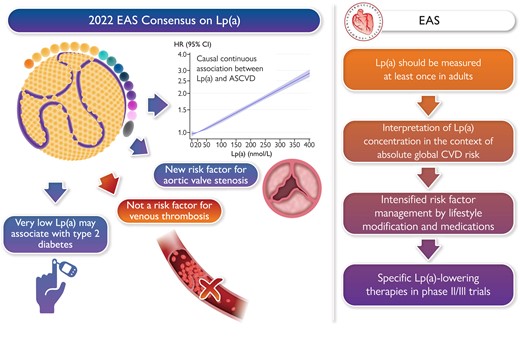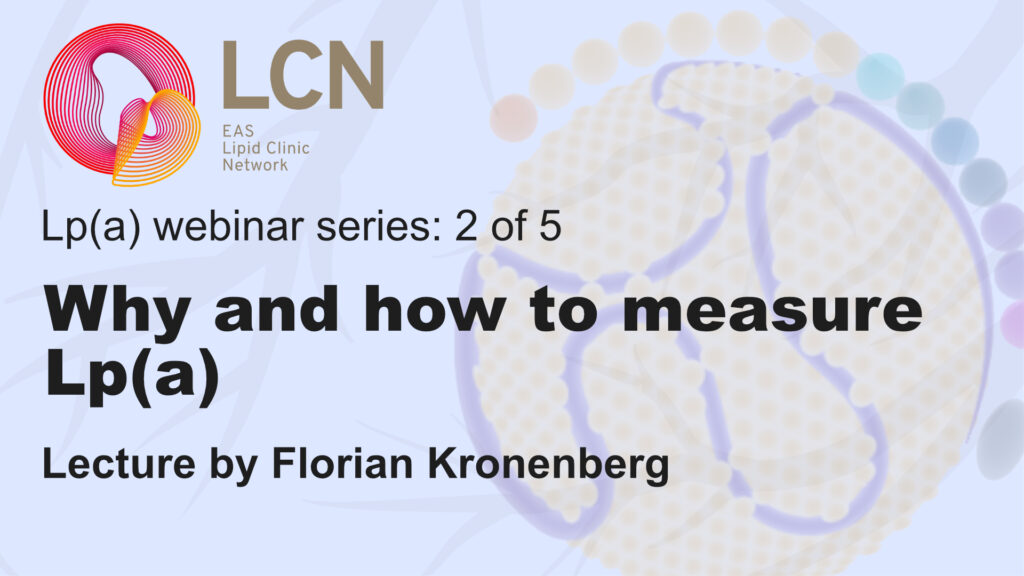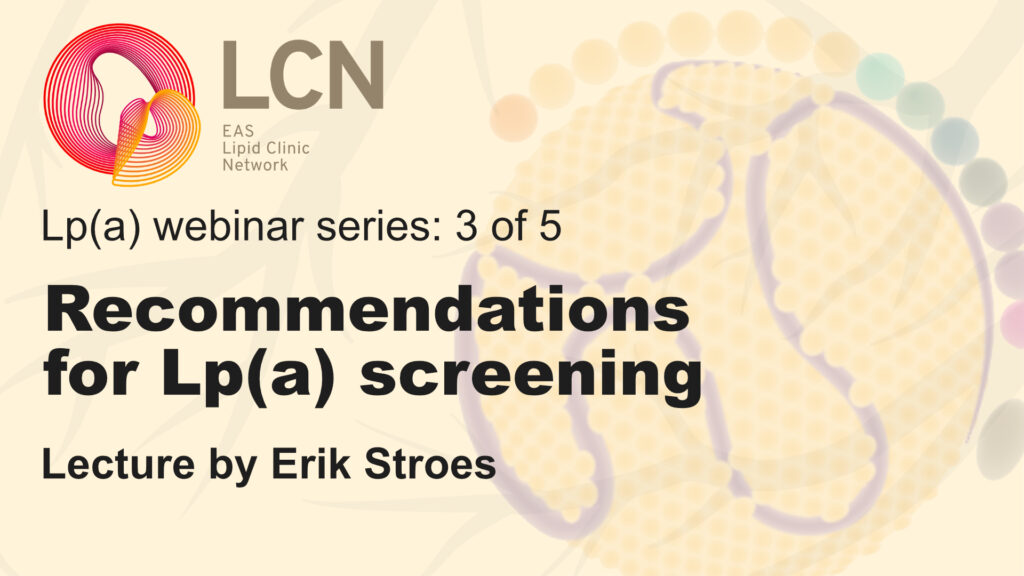Welcome to Lp(a) Awareness Day 2024! We’re excited to present this special issue of the EAS newsletter, dedicated to providing you with the latest updates and insights on lipoprotein(a).
In this edition:
- We have a big announcement: lipoprotein(a) testing at EAS Congress 2024!
- Discover the significant role of Lp(a) in cardiovascular health
- Explain essential key terms for clinicians to understand
- Present expert perspectives and recent research findings
Join us as we unite to increase awareness, promote education, and support efforts to improve health outcomes associated with Lp(a). Find more information using the hashtags: #KnowLpa and #LpaAwarenessDay.
Let’s make Lp(a) Awareness Day 2024 a truly impactful event!
The EAS announces lipoprotein(a) testing at EAS Congress 2024!

On Lipoprotein(a) Awareness Day, the EAS is pleased to confirm that delegates at EAS 2024 will have the opportunity to know their lipoprotein(a) level. The testing booth will be open on May 27-28.
This initiative aligns with the mission of the EAS to decrease the burden of preventable cardiovascular disease. EAS gratefully acknowledge the contribution of FH Europe Foundation (FHEF) to this activity. We encourage you to visit the FHEF booth to find out about the lived experience of lipid disorders, familial hypercholesterolemia (FH) and elevated Lp(a).
EAS have independently organised all matters related to this activity. We gratefully acknowledge financial support from Novartis Pharma AG.
Why is this important?
One in 5 people worldwide are at increased risk of atherosclerotic cardiovascular disease due to a high Lp(a) level. Evidence for this was the focus of the 2022 Updated EAS Consensus Panel Statement on Lp(a).1
The 2019 European Society of Cardiology/EAS Joint Dyslipidaemia Guidelines recommend measuring Lp(a) at least once during an individual’s life.2 However, this is often overlooked in clinical practice. As Lp(a) concentration interacts with other risk factors to increase global cardiovascular risk, failure to take the Lp(a) level into account will underestimate this risk.
High Lp(a): think about patients and their families
Lp(a) testing at EAS Congress 2024 will help delegates gain insight into how a high Lp(a) level affects patients and their families. Knowing the Lp(a) is crucial for personalising risk factor modification to reduce the patient’s global risk of preventable cardiovascular disease.
So at EAS Congress 2024, find the EAS booth, know your Lp(a) pathway.
1. Kronenberg F, Mora S, Stroes ESG, et al. Lipoprotein(a) in atherosclerotic cardiovascular disease and aortic stenosis: a European Atherosclerosis Society consensus statement. Eur Heart J 2022;43:3925-46.
2. Mach F, Baigent C, Catapano AL, et al. 2019 ESC/EAS Guidelines for the management of dyslipidaemias: lipid modification to reduce cardiovascular risk. Eur Heart J 2020;41:111-88.
Lipoprotein(a): What clinicians need to know
Elevated lipoprotein(a) is the most common dyslipidaemia. People with a high Lp(a) level are at increased risk of cardiovascular disease (CVD), such as heart attacks and stroke. But knowing the Lp(a) level, clinicians can take action to reduce the risk of preventable CVD in these patients.
What is Lp(a)?
Lp(a) is an LDL-like lipoprotein which also contains another lipoprotein, apolipoprotein(a).
Why is Lp(a) important?
The 2022 EAS Consensus Statement reinforced evidence for high Lp(a) as a causal risk factor for atherosclerotic cardiovascular disease (ASCVD) and aortic stenosis.This risk is independent of LDL‑C, as well as other risk factors.
What determines the Lp(a) level?
Lp(a) concentration is mainly determined by genetics (>90%), more than any other lipoprotein.
How is Lp(a) measured?
Lp(a) concentration can be measured as mass units (mg/dL or mg/L), or as particle numbers (nmol/L). The 2022 Consensus Statement does not recommend a standard factor to convert between these units as the mass of Lp(a) particles is variable.
What is a high Lp(a) level?
High Lp(a) has been defined by guidelines as >50 mg/dL or >125 nmol/L. However, it may be better to consider the Lp(a) level in the context of global cardiovascular risk, using ‘grey’ zones around these levels to rule-in/rule-out risk.
How much does a high Lp(a) level increase global cardiovascular risk?
The effect of a high Lp(a) needs to be interpreted in the context of the cardiovascular risk factor burden in the individual. A high Lp(a) value has a greater impact on absolute global risk if a person has several cardiovascular risk factors compared with those with none or a low number.
You can estimate the effect of the Lp(a) level on risk for heart attack or stroke using the Lp(a) clinical guidance risk calculator.
Are all people with a high Lp(a) level at high risk of cardiovascular disease?
No. Global cardiovascular risk depends on the total burden of risk factors. If a person has a high Lp(a) level but no other major risk factors, their risk for a cardiovascular event could be up to 50% lower than for a person with a normal Lp(a) level but with other major cardiovascular risk factors.
Explore the latest in lipidology with EAS Consensus 2022

Consensus Co-chairs:
Florian Kronenberg, Samia Mora, Erik S.G. Stroes
Panel members:
Brian A. Ference, Benoit J. Arsenault, Lars Berglund, Marc R. Dweck, Marlys Koschinsky, Gilles Lambert, François Mach, Catherine J. McNeal, Patrick M. Moriarty, Pradeep Natarajan, Børge G. Nordestgaard, Klaus G. Parhofer, Salim S. Virani, Arnold von Eckardstein, Gerald F. Watts, Jane K. Stock
Consensus Coordinators:
Kausik K. Ray, Lale S. Tokgözoğlu, Alberico L. Catapano
Published August 29, 2022
European Heart Journal, 2022
More than a decade after first highlighting Lp(a), the European Atherosclerosis Society (EAS) has published an updated consensus statement. This 2022 statement brings together extensive evidence for elevated Lp(a) concentration as a causal risk factor for atherosclerotic cardiovascular disease (ASCVD), irrespective of gender and ethnicity, as well as for aortic valve stenosis, and provides practical guidance on testing and treating high Lp(a) levels.
To the full paperTo the commentaryLp(a) Clinical Guidance – estimating the risk of heart attack & stroke caused by Lp(a)

Lp(a) Clinical Guidance is a website, launched in connection with the EAS Consensus position paper on Lp(a). It is intended for use by the general public, to help them understand their Lp(a) levels, and by clinicians, to help them better manage their patients with elevated Lp(a).
Lp(a) Clinical Guidance will help you determine how much your Lp(a) level increases your risk of having a heart attack or stroke and also provide you with specific guidance about what you can do to lower your risk if your Lp(a) level is elevated.
To the Lp(a) Clinical GuidanceCelebrate this day with us and enroll in our new Certificate in Lipidology for Nurses and HCPs!

Are you a nurse or healthcare professional in lipid clinics, eager to tackle challenges related to atherosclerotic vascular disease in your daily work? Or perhaps you’re interested in gaining their perspective on the topic?
Your chance is here! Join us in celebrating Lp(a) Awareness Day and enhance your skills by enrolling in our new Lipidology Certificate for Nurses and Healthcare Professionals!
As an EAS member, enjoy a 50% discount from the regular price.
Take the Certificate in Lipidology for Nurses and Healthcare ProfessionalsExplore the implications of the paper’s conclusions for clinical practice through the LCN Lp(a) webinar series

For those seeking a deeper understanding of the implications of the paper’s conclusions for clinical practice, we recommend visiting the EAS Academy. Explore our series of five Lp(a) webinars, which cover topics such as what Lp(a) is, how to measure it, recommendations for screening, therapeutic approaches, and the practical implications of these findings.
If you’d like to watch a specific webinar, please click on the corresponding banner below.
EAS has independently created and organised all scientific and practical aspects of this activity. We gratefully acknowledge a financial healthcare sponsorship provided by Novartis in support of the organisation of the work.
To the Lp(a) webinar seriesWatch Lp(a) related sessions from EAS Congress 2023 at your convenience on EAS Academy

Missed out on the lipoprotein(a) related sessions at EAS Congress 2023? No worries! All lectures, including these ones, are accessible anytime on EAS Academy.
Our content stands as a beacon of credibility, offering you unparalleled insights into the field. Stay in the loop with the latest cardiovascular health advancements:
Going beyond LDL-C: why is Lp(a) critical in current clinical practice? by Prof. Christie BallantynePanel Discussion: From evidence to action with elevated Lp(a) perspectives on clinical implications and testingWhat do we need to do? A call to action on Lp(a) testing by Prof. Florian KronenbergLp(a) – Finding the right place by Prof. Florian KronenbergWhat Lp(a)-related sessions are planned for this year’s Congress?

Excited to learn more at this year’s Congress? Check out the sessions about Lp(a) topics. And if you haven’t registered yet, make sure to save your spot in Lyon!
- NLA-EAS Joint session – From a to B, then Back to LDL: Transatlantic Views on the Lipoproteins that Cause Plaque (Joint Symposium, Mon, 27.05.2024, 11:00 – 12:30)
1. Disaggregating the lipid panel- why should I bother?, Christie Ballantyne (USA)
2. Lp(a) who to measure and what to do about it?, Florian Kronenberg (Austria)
3. To apoB or not to apoB, Daniel E. Soffer (USA)
4. LDL-C lowering across the spectrum of dyslipidemias – why it remains the primary target, Kausik Ray (United Kingdom)
- Precision medicine beyond LDL-cholesterol (Workshop – Risk factors, Tue, 28.05.2024, 15:45 – 17:15)
1. Lipoprotein (a) molecular mechanisms associated with athero-thrombosis: a topic for precision medicine, Gilles Lambert (Reunion Islands)
2. Women and ASCVD: what is different?, Lale S. Tokgözoğlu (Turkey)
3. Apolipoprotein E concentrations are predictive of recurrent strokes: insights from the SPARCL trial, Gilles Lambert (Reunion Islands)
4. Remnant cholesterol, not LDL cholesterol, explains peripheral artery disease risk conferred by apolipoprotein B: a cohort study, Benjamin N. Wadström (Denmark)
5. Sex-specific plasma-proteome of incident coronary artery disease, Raymond Noordam (Netherlands)
6. Risk of pregnancy- and birth-related outcomes in women with familial hypercholesterolemia versus age-matched controls, Karianne Svendsen (Norway)
Register for the EAS Congress 2024Atherosclerosis Journal: articles focusing on Lp(a)
This collection encompasses a series of articles, including a special issue, all dedicated to exploring various aspects of Lp(a). Authored by esteemed experts in the field, these contributions delve into the intricacies of Lp(a) biology, its association with cardiovascular diseases, diagnostic methods, therapeutic interventions, and its emerging role in personalized medicine.
By synthesizing current research findings and clinical insights, this compilation provides a comprehensive overview of Lp(a) and its pivotal significance in comprehending, diagnosing, and managing cardiovascular health.
Lipoprotein(a), vol. 349Frequent questions and responses on the 2022 lipoprotein(a) consensus statement of the European Atherosclerosis SocietyElevated lipoprotein(a) increases risk of subsequent major adverse cardiovascular events (MACE) and coronary revascularisation in incident ASCVD patients: A cohort study from the UK BiobankHigher prevalence of coronary microvascular dysfunction in asymptomatic individuals with high levels of lipoprotein(a) with and without heterozygous familial hypercholesterolaemiaEngage with Atherosclerosis Journal’s quiz
Celebrate Lp(a) Awareness Day with Atherosclerosis Journal! Follow their Twitter (X) account where they’ll share interesting questions for you to answer quickly. It’s a delightful fusion of learning and enjoyment that you won’t want to overlook. Test your knowledge and join the excitement!
Follow Atherosclerosis Journal on Twitter (X)



